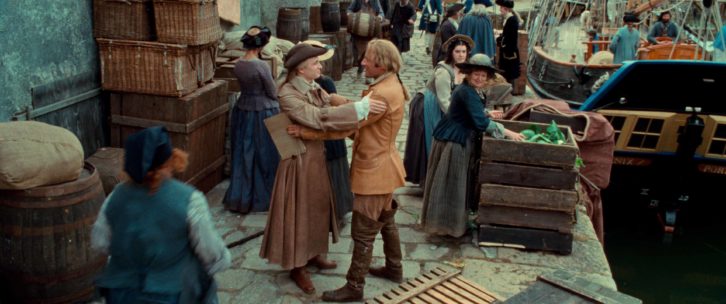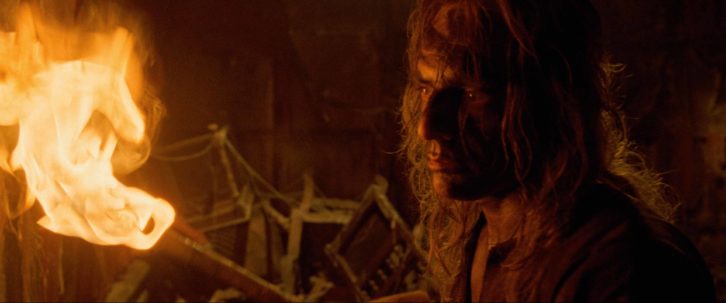Released in 2001 and directed by Christophe Gans, Brotherhood of the Wolf quickly made a name for itself, thanks to an uncommon blend of horror, martial arts and period drama.
Previously known for his live-action adaptation of Crying Freeman, Gans continued the momentum, adapting a story based on the Beast of Gévaudan. The film takes place in 1766, in southwest France, where a terrifying creature haunts the mountains, attacking men and animals with great ferocity.
Jérôme Bigueur, a senior colorist at Hiventy, looks back at this long-running project, reflecting on how much has changed in two decades. “When you think about it, the movie is only 20 years old,” he begins. “Yet we’ve transitioned from film to digital in that time. At the time, digital colour grading was still a relatively new process, as were the techniques for scanning and digitising film and subsequently mastering back a 35mm film negative for projection.”
While any changes to the story itself were out of the question, the director did want to adapt the film for more modern viewing while addressing some of the issues arising during the mastering process.
Remastering for 4K
Originally filmed in 35mm and scanned in a 2K 8-bit in the early 2000s, it quickly became apparent that the digital scans from 2000 wouldn’t be sufficient for remastering in 4K Dolby Vision.

“With Eric Martin, Hiventy’s workflow supervisor, we very quickly saw the limits of colour reproduction in those files,” explains Bigueur. “The quality of the colour space and definition in the original scans was drastically different to what is achievable with a 4K 16-bit negative scan today. Thanks to the support of Studiocanal and Metropolitan, we were able to rescan and reassemble the entire film shot by shot, ensuring the feature was remastered in the best possible quality.”
The decision to use an ACES colour managed pipeline saw the 35mm film reels scanned as 16-bit DPX ADX files for maximum flexibility. Sebastien Prangere, the original editor of the film, reassembled the offline edit in Avid Media Composer with the grade, conform and finish completed in DaVinci Resolve Studio.
When it came to the Dolby Vision grade, Bigueur was lucky to have the feature’s original colourist, Jean-René Nebot, on hand for support. “Jean-René is one of my mentors. I had the pleasure of consulting him on his original artistic direction for the original film,” says Bigueur. “He even shared the successes and constraints of early digital colour grading. I was hugely appreciative of his support and those insights.”
Working with the editor was also essential in achieving the best grade, and DaVinci Resolve was vital to this collaborative workflow. Mathieu Liron was in charge of the conform and acted as a liaison between the editing department and the colourist.
“When you are lucky enough to work with a great cinematographer like Dan Laustsen, you know that you’ll have incredible, rich images that were shot well in the first place,” says Bigueur.
The two outdoor fight sequences at the start proved to be some of the most challenging and exciting scenes to work on. “These were multi-camera, multi-day shots, with the original production enduring the four seasons weather wise,” Bigueur explains.
“I also liked the hotel sequences featuring the beast, where we had to rely on a mix of newly composited VFX and original rushes to rebuild. The quality of scans meant that an alignment by density or color was enough to work with in the DI. Likewise, the HDR tools in Resolve gave me greater control over the graded allowing more nuance in the storytelling.”
Unlocking new creative choices
An ACES colour-managed workflow was implemented for the Dolby Vision grade with Bigueur, then completing a scene by scene trim pass. “The arrival of HDR has unlocked a wealth of creative choices and is changing how we work. The trick is to know when and how to use the full range of rec2020,” he explains.
“In this particular instance, we have quite a dark film, but we wanted to avoid it looking flat.”

“We focused much of our efforts on the torch-lit scenes, working to recover as much detail in the shadows and making the blacks look deeper. In the case of the torches, we didn’t need to zone control all of the flames to make them watchable, as would have been the case in SDR. Instead, we focused on the ones we wanted to direct the viewer’s eye away from the action and add nuance.
“Appling the curves and power windows via the DaVinci Resolve Advanced Panel ensured I could make quicker and more efficient choices during the DI.”
Power of collaboration
As for advice, Bigueur says important it is to surround yourself with the original creatives when remastering work.
“It is worth remembering that the film had already benefited from digital colour grading at the time. And while you must remain respectful of the original creative intent, why not reimagine the image as it should have been had those tools and technologies existed then?
“Involving and collaborating with elements from the original production and post production teams, gave us far more latitude to push boundaries and get closer to the original creative vision, which is what Christophe Gans ultimately wanted.”
Bigueuer continues: “Brotherhood of the Wolf is a film with a powerful visual identity. My role as the colourist was to give back the character and power that the film had on its debut and propel fans old and new into this great French classic. And hopefully, this new master will be a cinematic reference for a long time to come.”
The final project deliverables included a P3 DCI master with Dolby Atmos audio mix for theatrical releases and ProRes XQ versions in HDR10, HDR10+ and Dolby Vision. There was also a UHD SDR master for Bluray and VoD mastering.







